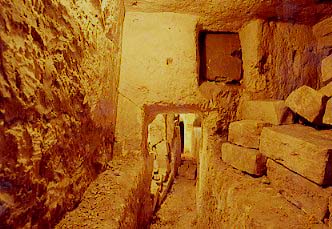
The Hypogeum Complex under the Wignacourt Collegiate Museum

|
Location: | |
|
The Wignacourt Collegiate Museum Hypogeum complex is found in the ground floor of the Wignacourt Museum, Rabat (Malta). | |
|
Discovery Ancient burial sites have been known from Rabat since at least the seventeenth century. The complex under the Wignacourt Museum was found in the early twentieth century during construction work on the site. Sir Themistocles Zammit, as the Museum's director, was called on site to examine the remains but due to the urgency of the construction works could only preserve the tombs by roofing parts of the complex, without further study of the remains. The complex was discovered, or indeed refashioned, in the second World War when the different burial chambers were combined through a shelter corridor into one complex. |
|
|
|
Description The second World War corridor has brought together two main areas. An L-shaped corridor passes alongside and also through late Punic and Romano-Byzantine burial chambers, terminating into three curious rooms. The other space is dominated by two rows of Baldacchini which are architecturally the later part of the complex
|
|
Passing through the corridor one encounters burial features which are typical of the period represented. These include loculi, window tombs, baldacchini and late punic chambers (see tomb types in Roman Malta for details). Yet in itself the complex has a number of features which are not readily appreciated elsewhere. Indeed the repetitive use of the same area for different funerary requirements is most explicitly revealed in the complex with a succession of tomb features found within the same area.
|
|
|
The complex also reveals the common post-classical transformation of underground burial chambers. Indeed when discovered, many of the late Roman and Byzantine Tombs found in the Maltese Islands were already turned into animal pans,wells, cave dwellings, underground storage rooms or medieval chapels. In the Wignacourt Museum complex they were transformed into a shelter. | |
Contact author by E-Mail
(c) Images and Text Anton Bugeja July 2003